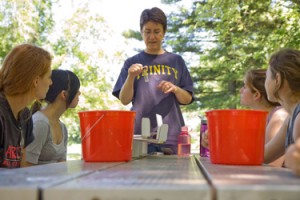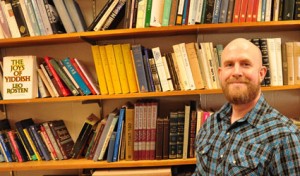With a goal of applying theory to a real-world problem, Trinity College Professor of Engineering Taikang Ning has received funding from Lam Research Foundation to continue his research on the application of discrete-wavelet transform (DWT) to extract signal features and detect faults during wafer fabrication. The grant of $25,000 will support Ning’s work on image compression, which encodes an original digital image using a smaller amount of data storage. Companies in all industries are seeking to store and process data and images in more efficient and cost-effective ways, Ning said.
 The collaborative effort between Ning and his students led to the development of a data compression source code that was integrated into the Lam Research Corporation’s beta test to demonstrate the program’s effectiveness. Subsequently, Ning released a jointly published paper with Lam Research in October 2014, and has built a strong working relationship with the organization. This is the third year in which Ning has received funding from Lam Research Foundation.
The collaborative effort between Ning and his students led to the development of a data compression source code that was integrated into the Lam Research Corporation’s beta test to demonstrate the program’s effectiveness. Subsequently, Ning released a jointly published paper with Lam Research in October 2014, and has built a strong working relationship with the organization. This is the third year in which Ning has received funding from Lam Research Foundation.
Ning said that his project proposal was selected eighth out of 20 projects that were funded, from a pool of about 50 applicants. The professor is proud that a small liberal arts college like Trinity was selected by Lam, which typically works with large research universities. “The emphasis of faculty at research universities is often to seek funding to support programs and Ph.D. graduate students,” Ning said. “In our case at Trinity, we as faculty focus solely on undergraduates and we need to know every bit of the technical part before we train our students. Our strength is that we are confident of what we can accomplish before we apply for research funding.”
Ning said that the grant will help provide his students with research opportunities as undergraduates by funding research stipends and equipment needs. “It is a good learning experience for students. They become familiar with the semiconductor industry’s challenges and develop solutions to solve them,” he said. Since DWT is not included in Trinity’s engineering courses, Ning initially spends time with research assistants on a one-on-one basis explaining the theory. Once he gains confidence in a student’s understanding of the concept, he allows the student to work more independently on developing DWT-based compression programs.
This research funding also provides Trinity students with an insight into a possible career path by getting hands-on experience. “To them, it’s learning to engage an industry problem that they would never have a chance to know from class,” Ning said.
Written by Bhumika Choudhary ’18











 Samuel S. Kassow ’66, Charles H. Northam Professor of History, was honored this week in Warsaw, Poland, for his service to Polish Culture. Polish Minister of Culture and National Heritage Malgorzata Omilanowka, presented a medal to Kassow in a ceremony on Monday, February 16.
Samuel S. Kassow ’66, Charles H. Northam Professor of History, was honored this week in Warsaw, Poland, for his service to Polish Culture. Polish Minister of Culture and National Heritage Malgorzata Omilanowka, presented a medal to Kassow in a ceremony on Monday, February 16.

